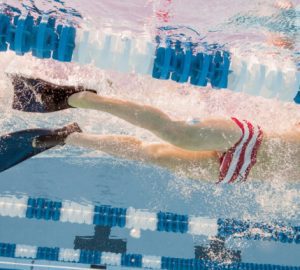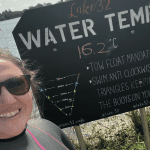How to cut 5% off your mile time
If you’re training for the Henley Mile or a 1 mile Great Swim event this year, you may be wondering if it’s possible to improve your time by 5%. Lorraine Rate, our Water Slaves coach, says it is.
This guide is primarily aimed at beginner to intermediate swimmers. Advanced swimmers will clearly find it harder to drop their times by 5%, but improvements are almost always possible.
Step 1 – Identify the factors needed to achieve your 5% goal
- DRILLS, DRILLS, DRILLS. Practice those technique drills at every opportunity, they will feel horrible at first, but the more you do them, the more comfortable you will feel. Nobody’s stroke is so perfect that they need to bypass drills!
- Core body strength exercises. Just google ‘Core body strength exercises for swimmers’ and you will find a variety of core exercises purely for swimmers.
- Nutrition. If you are not feeding your engine with the right fuel, you will get poor results. Again, research what quantities of carbs/proteins/fats you should be consuming, before, during and after exercise in order to get the maximum results.
- Your Lifestyle. Does your lifestyle allow you the necessary time to put the work in? Your week should ideally consist of at least 3 sessions to the pool and the same in core body strength exercises.
Step 2 – Structure your sessions effectively
- Approx 12-15% of the time available should be used as a warm up. (Swim in your Aerobic zone i.e. 60-80% effort) – In a warm up, swim slowly, stretching your muscles. Do a variety of strokes and really concentrate on loosening everything up.
- Approx 12-15% of the time available should be used to work on your drills. These are swim exercises. Work on your weaknesses. (Work in your aerobic zone again, i.e. giving 60-80% effort). Your drills will be different for everyone. Your stroke coach will be able to tell you what you need to work on).
- Approx 20%, (but anything up to 35%) of your time should be HARD WORK. (80-90% effort) – this is what is known as working in your endurance zone). This is the most important part of your training session as far as reducing your 1mile time by -5% goes. Your training sets should be geared around achieving that goal.
- Approx 12-15% of each session should be in your anaerobic zone. 90-100% effort. Yes – 100% effort. It’s tough which is why it is usually just geared round 25metre sprints with long rest intervals and often done at the end of a training session. It just reminds our memory muscles what swimming fast feel like.
- And the final % of time left is your swim down. Do ensure you swim down at the end of every session. Move back into your aerobic zone, just 60% effort and take at least 10mins getting the lactate acid and heart rate back to normal.
Step 3 – Do the work
Having established that it is the work we do in the endurance part of each session that is the most important bit to improve our stamina and speed, what do we do to ensure maximum results? Let’s do some sums. You need to know your current 1 mile to do this – go out and time yourself if you don’t!
What is your current personal best 1 mile time?
Example = 25minutes.
This would give an average time for each 100metres of 93.75 seconds.
25 minutes, minus 5% = 23minutes 45 seconds.
So I now know that I am aiming to average each 100metres at 89.06 seconds to achieve my 5% goal.
Do the same calculation for your time.
Once you know the pace you need to be swimming at to achieve your 5% goal you can start training at it. So when training in the endurance part of each session, in my example, I now know I am aiming to maintain a speed of 89.06 secs per 100m for 1600metres (1mile).
So how do we do that? Working on your figures, establish how much rest you need between each 100metres to maintain your pace. You may initially need over a minute’s rest or more, between each 100m, in order to repeat 89.06, 16 times.
Secondly, when you are fresh and not tired, the first 100m is usually faster. We don’t want that. It is important to train our mind and body into learning how to pace ourselves and to know exactly what it feels like to swim at target pace. Once this is achieved, your memory muscles will know exactly what they should be doing. Incidentally, if you are in the habit of swimming your first 100m too fast, you may never be able to maintain a consistent pace over a mile.
As the weeks/months go on, you need to be working on A) bringing the rest down in between each 100m and B) increasing the amount you can do at that pace. Try just 6 x 100metres first with a minutes rest between each. If you didn’t manage to maintain the pace then increase your rest period. If you did manage it, leave the rest at 1 minute but try for 10 or even try to get to 16.
Jot your results down each time you return home. If you are serious about achieving your target, then you need to be monitoring your progress on paper as well as in the water, otherwise there is no structure in place ready for your next visit to the pool.
Step 4 – Add variety
There are dozens of variations you can do to relieve the boredom but that are all working on achieving the same result. Here are just a few variations based on my example:
- 8 x 200 with 1 minute’s rest after each 200 (try to maintain the 89.06, so the 200m time you are aiming for is sub 3mins.
- 5 x 300, you may need more than 1 minutes rest after the 300m stage in order to maintain a consistent pace for each 300metres of just under 4mins 30secs.
- To add speed, split each 100m. So instead of taking 1min rest after the 100m, take 20 secs after 50metres, then take the remaining 40secs of your allowed rest at the 100m point. This will help you to swim faster on each 50m.
- Fartlek Training. Swim 100m very fast and instead of taking 1 minutes rest, swim the next 100metres as a recovery, then try the next 100m fast again.
The above method is tried and tested by myself and several of my ‘Water Slaves’ from the Chalkwell Redecaps Open Water Swimming Club. And it is working. I do hope it works for you.
Click here for some swimming training sessions from Lorraine.







